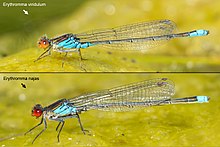Big shell eye
| Big shell eye | ||||||||||||
|---|---|---|---|---|---|---|---|---|---|---|---|---|

Great shell-eye ( Erythromma najas ), male |
||||||||||||
| Systematics | ||||||||||||
|
||||||||||||
| Scientific name | ||||||||||||
| Erythromma najas | ||||||||||||
| ( Hansemann , 1823) |
The great garnet eye ( Erythromma najas ) is a dragonfly from the family of the slender dragonflies (Coenagrionidae). In terms of its distribution, it is considered a Euro-Siberian element of fauna.
features

The large shell eye is 35 millimeters long and has a wingspan of almost 50 millimeters. The males have bright garnet-red eyes, the sides of the chest and the last two abdomen segments are light blue. The species can be confused with the lesser garnet eye ( Erythromma viridulum ), in which the males have an X-shaped, black mark on the top of the 10th abdomen segment at the tip of the abdomen . This segment is completely blue in males of the great shell-eye. On the other hand, they lack the blue color on the sides of the 2nd and 8th segment. The matt black markings of the yellowish to green female are reminiscent of a female Azure damsel ( Coenagrion spp.); but he lacks a bright spot between his eyes. To distinguish it from females of the lesser garnet eye, the rear edge of the front breast ( prothorax ) must be considered; This has wave-shaped bulges in the Big Grenade Eye.
Habitat and Distribution
This type of dragonfly likes to sit on the leaves of pond and water lilies in larger bodies of water with a species-rich underwater flora. It is quite shy and rarely leaves the direct area of the water surface. The great shell-eye lives far across Europe, in Asia up to Japan and in the north beyond the Arctic Circle, in southern Europe there are only a few stray finds. In contrast, it occurs relatively frequently in Central Europe.
Reproduction
The flight time is from May to the end of August. The males are robust and persistent fliers who occupy a territory of three to six meters on the water and defend quite aggressively against competitors, but also other species (even dragonflies). The couple lays the eggs in stems of aquatic plants, whereby in extreme cases they can submerge up to 60 cm in the water and remain there for almost an hour. In some cases, the male disconnects before fully diving and waits on the surface for the female to return. Once this has finished its submerged egg-laying, it lets go of the plant stem and floats upwards like a cork. The very fast and lively larvae develop on the bottom of the water and in the reed beds. They are relatively large for a slender dragonfly and have broad, darkly banded gill leaves. They usually hibernate in the last stage of development.
swell
literature
- Heiko Bellmann: The Kosmos dragonfly guide . Franckh-Kosmos Verlags GmbH & Co., Stuttgart 2007, ISBN 978-3-440-10616-7
- Klaus Sternberg & Franz-Josef Schiel: Erythromma najas (Hansemann, 1823) - Large Grenade Eye. P. 311–322 in: Sternberg / Buchwald (ed.): Die Libellen Baden-Württemberg. Volume 1: General part, dragonflies (Zygoptera). Ulmer, Stuttgart 1999, ISBN 3-8001-3508-6
